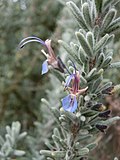Top Qs
Timeline
Chat
Perspective
Rosmarinus
Clade of herbs From Wikipedia, the free encyclopedia
Remove ads
Rosmarinus (/ˌrɒsməˈraɪnəs/ ROSS-mə-RY-nəs[2]) is a small taxonomic clade of woody, perennial herbs with fragrant evergreen needle-like leaves in the family Lamiaceae, native to the Mediterranean Basin.
This article needs additional citations for verification. (April 2009) |
In 2017 the species in the genus Rosmarinus were moved into the large genus Salvia based on taxonomic evidence.[3] Thus Rosmarinus is no longer a genus, but still a monophyletic clade of species within Salvia.
Remove ads
Description
Salvia rosmarinus (rosemary), widespread in the Mediterranean region, and Salvia jordanii (formerly Rosmarinus eriocalyx), native to northwest Africa and southern Spain have long been widely recognized. Salvia granatensis (formerly Rosmarinus tomentosus) was first recognized as a separate species in 1941. Rosmarinus palaui was first described as a species in 2002, although recognition of this species remains controversial. Recent research has indicated that while S. granatensis forms a monophyletic group, this group is nested within a paraphyletic S. jordanii.[4]
Salvia jordanii differs from the well-known herb rosemary in its smaller leaves, only 5–15 mm (0.20–0.59 in) long and less than 2 mm (0.079 in) broad, and densely hairy flower stems. It also tends to be lower-growing, often under 25 cm (9.8 in) tall and prostrate, and never exceeding 1 m (3 ft 3 in) tall (S. rosmarinus can reach 1.5 m (4 ft 11 in), exceptionally 2 m (6 ft 7 in), tall).
Rosemary can be propagated from seed or cuttings in summer,[5] and can be spread by carelessly discarding garden waste.[6]
Remove ads
Species
- Species and nothospecies accepted by the Kew World Checklist[7]
Remove ads
Natural hybrids
References
External links
Wikiwand - on
Seamless Wikipedia browsing. On steroids.
Remove ads





